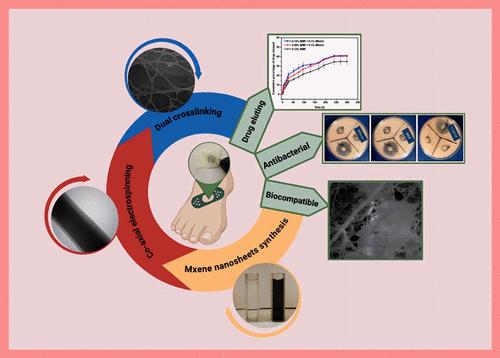当前位置:
X-MOL 学术
›
ACS Appl. Bio Mater.
›
论文详情
Our official English website, www.x-mol.net, welcomes your
feedback! (Note: you will need to create a separate account there.)
Drug-Eluting and Antibacterial Core–Shell Polycaprolactone/Pectin Nanofibers Containing Ti3C2Tx MXene and Medical Herbs for Wound Dressings
ACS Applied Bio Materials ( IF 4.6 ) Pub Date : 2024-11-05 , DOI: 10.1021/acsabm.4c00880 Morvarid Koohkhezri, Roya Lotfi, Nooshin Zandi, Zahra Emami, Elnaz Tamjid, Abdolreza Simchi
ACS Applied Bio Materials ( IF 4.6 ) Pub Date : 2024-11-05 , DOI: 10.1021/acsabm.4c00880 Morvarid Koohkhezri, Roya Lotfi, Nooshin Zandi, Zahra Emami, Elnaz Tamjid, Abdolreza Simchi

|
Fibrous scaffolds capable of delivering natural drugs and herbs show great promise for tissue regeneration and wound care, particularly in personalized medicine. This study presents the fabrication and characterization of drug-eluting antibacterial core–shell mats composed of polycaprolactone (PCL) and pectin nanofibers produced through coaxial electrospinning. Berberine chloride (BBR), an herbal compound with antineoplastic, anti-inflammatory, antilipidemic, and antidiabetic properties, served as the model drug. Poly(vinyl alcohol) (PVA) was blended with pectin to enhance the mechanical properties of the core fibers. The shell was modified with two-dimensional Ti3C2Tx (MXene) nanosheets and subjected to covalent and ionic cross-linking. Structural analysis confirmed the successful production of bead-free fibers with diameters ranging from 160 to 350 nm, depending on composition. The PCL core fibers were uniformly coated with a pectin/PVA shell approximately 90 nm thick. The inclusion of BBR and MXene increased the fiber diameter. Drug-release kinetics, modeled by using Korsmeyer-Peppas, revealed a two-stage release mechanism. An initial burst release occurred within the first 24 h (kinetic exponent n = 1.36), followed by sustained release over 2 weeks (n = 0.48). The release mechanisms were identified as case-II relaxational release in the first stage, transitioning to quasi-Fickian diffusion in the second. Incorporating MXene into the shell further prolonged drug release. The mechanical strength of the scaffolds improved significantly by a factor of 7 and 4 in wet and dry conditions, respectively. In vitro biocompatibility assays using L929 cells demonstrated excellent cell attachment and compatibility. Additionally, antibacterial tests against Escherichia coli showed that the inclusion of MXene enhanced antibacterial activity by 30%. These results suggest that the functional biocomposite scaffolds hold the potential for developing innovative, drug-eluting wound dressings.
中文翻译:

含有 Ti3C2Tx MXene 的药物洗脱和抗菌核壳聚己内酯/果胶纳米纤维和用于伤口敷料的药材
能够输送天然药物和草药的纤维支架在组织再生和伤口护理方面显示出巨大的前景,尤其是在个性化医学中。本研究介绍了由聚己内酯 (PCL) 和通过同轴静电纺丝生产的果胶纳米纤维组成的药物洗脱抗菌核壳垫的制造和表征。小檗碱氯化物 (BBR) 是一种具有抗肿瘤、抗炎、抗血脂和抗糖尿病特性的草药化合物,用作模型药物。将聚乙烯醇 (PVA) 与果胶混合以增强芯纤维的机械性能。壳层用二维 Ti3C2Tx (MXene) 纳米片修饰,并进行共价和离子交联。结构分析证实,根据成分的不同,成功生产了直径范围为 160 至 350 nm 的无珠纤维。PCL 芯纤维均匀涂有约 90 nm 厚的果胶/PVA 壳。BBR 和 MXene 的加入增加了纤维直径。使用 Korsmeyer-Peppas 建模的药物释放动力学揭示了两阶段释放机制。初始爆发释放发生在前 24 小时内 (动力学指数 n = 1.36),然后是持续释放超过 2 周 (n = 0.48)。释放机制在第一阶段被确定为案例 II 弛豫释放,在第二阶段过渡到准 Fickian 扩散。将 MXene 掺入壳中可进一步延长药物释放时间。支架的机械强度在潮湿和干燥条件下分别显著提高了 7 倍和 4 倍。 使用 L929 细胞的体外生物相容性测定显示出优异的细胞附着和相容性。此外,针对大肠杆菌的抗菌测试表明,MXene 的加入将抗菌活性提高了 30%。这些结果表明,功能性生物复合支架具有开发创新的药物洗脱伤口敷料的潜力。
更新日期:2024-11-05
中文翻译:

含有 Ti3C2Tx MXene 的药物洗脱和抗菌核壳聚己内酯/果胶纳米纤维和用于伤口敷料的药材
能够输送天然药物和草药的纤维支架在组织再生和伤口护理方面显示出巨大的前景,尤其是在个性化医学中。本研究介绍了由聚己内酯 (PCL) 和通过同轴静电纺丝生产的果胶纳米纤维组成的药物洗脱抗菌核壳垫的制造和表征。小檗碱氯化物 (BBR) 是一种具有抗肿瘤、抗炎、抗血脂和抗糖尿病特性的草药化合物,用作模型药物。将聚乙烯醇 (PVA) 与果胶混合以增强芯纤维的机械性能。壳层用二维 Ti3C2Tx (MXene) 纳米片修饰,并进行共价和离子交联。结构分析证实,根据成分的不同,成功生产了直径范围为 160 至 350 nm 的无珠纤维。PCL 芯纤维均匀涂有约 90 nm 厚的果胶/PVA 壳。BBR 和 MXene 的加入增加了纤维直径。使用 Korsmeyer-Peppas 建模的药物释放动力学揭示了两阶段释放机制。初始爆发释放发生在前 24 小时内 (动力学指数 n = 1.36),然后是持续释放超过 2 周 (n = 0.48)。释放机制在第一阶段被确定为案例 II 弛豫释放,在第二阶段过渡到准 Fickian 扩散。将 MXene 掺入壳中可进一步延长药物释放时间。支架的机械强度在潮湿和干燥条件下分别显著提高了 7 倍和 4 倍。 使用 L929 细胞的体外生物相容性测定显示出优异的细胞附着和相容性。此外,针对大肠杆菌的抗菌测试表明,MXene 的加入将抗菌活性提高了 30%。这些结果表明,功能性生物复合支架具有开发创新的药物洗脱伤口敷料的潜力。





















































 京公网安备 11010802027423号
京公网安备 11010802027423号